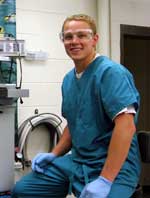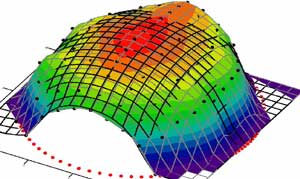Dan Woldtvedt Awarded 2007 Biomedical Engineering Society Award
 |
|
Dan Woldtvedt
|
Daniel Woldtvedt, mechanical engineering and biomedical science double major, was recently awarded the 2007 Biomedical Engineering Society (BMES) Undergraduate Research and Design Award. Recognized for his outstanding biomedical engineering research and paper on "Three-dimensional Cartilage Thickness Mapping of Cervical Facet Joints," Woldtvedt was honored with a certificate, stipend and registration for the Annual BMES Fall Meeting in Los Angeles, California.
Working under Dr. Christian Puttlitz, associate professor of mechanical engineering and integral member of the new School of Biomedical Engineering Leadership Team, Woldtvedt has been conducting research in state-of-the-art facilities, at the Colorado State Orthopaedic Bioengineering Research Laboratory (OBRL). The laboratory, part of the Musculoskeletal Program-- an interdisciplinary program between Colorado State's College of Veterinary Medicine and Biomedical Sciences and the College of Engineering -- is one of 16 Programs of Research and Scholarly Excellence at CSU.
Woldtvedt's work was a collaborative project initiated by graduate student Wes Womack, and was focused on incorporating the geometry of facet joints into a finite element model of the cervical spine. Facet joints, those linking vertebrae together, preserve flexibility in the spine and provide needed limits to motion, especially rotation. Together, both researchers successfully generated the first three-dimensional map of cartilage between cervical facet joints, relying heavily on mathematical algorithms.
Creating the three-dimensional map of cartilage involved dissecting cervical vertebrae from seven human cadavers, sectioning the vertebrae into 1 millimeter slices and photographing each slice alongside a scale. Womack was then able to write mathematical code used to define the cartilaginous regions on each slice as three-dimensional coordinates. Subsequently, a series of MathCad algorithms generated maps of the cartilage distribution.
Mechanical models like the one Womack is developing will provide numerous applications for biomedical advancements. The cervical facet cartilage maps have already been implemented into Womack's finite element model of the cervical spine, with a significant effect on its accuracy. This model is intended to simulate spine biomechanics, with the end result of understanding the effects of intervertebral disc replacements on load distribution at the facet joints.
"Working at the OBRL has been an incredible experience. Dr. Puttlitz and Wes, and the other graduate students have served as excellent mentors and really enriched my entire undergraduate experience," said Woldtvedt. "I've been able to work side by side with some of the University's best students and see firsthand how they are able to accomplish so much. On top of that, I've gained skills and knowledge at the OBRL that I would not have otherwise been exposed to until senior design or grad school."
In addition to his cervical facet joint research, Woldtvedt, a 2007 McNair Scholar, traveled to San Francisco this summer on an all-expense paid trip to present his first individual research project at the 2007 UC Berkeley McNair Scholars Symposium. After delivering his presentation titled "Diametral Compression: A Computational and Experimental Investigation for a New Bone Strength Test," Woldtvedt also had the opportunity to tour Stanford's world-renowned Medical Center.
Woldtvedt will soon be deciding among a diverse range of post-graduation options, including medical school, a Master's, Ph.D. or even dental school. He has already decided to seek admission at the University of Washington, renowned for their health-sciences and emphasis on rural health care.
"The many outstanding professors I have gotten to know, the classes I have taken, and the unique activities that I have been involved with outside the classroom have really allowed me to gain a diverse perspective on what opportunities exist in the future," said Woldtvedt. "Best of all, I feel like my engineering education has already instilled in me a problem-solving frame of mind and work ethic that I will carry forth into whatever career I pursue."
 |
|
A visual representation of the final 3-D map of cartilage for an arbitrary slice
|
To learn more about the new School of Biomedical Engineering at Colorado State University please visit http://www.engr.colostate.edu/bep/